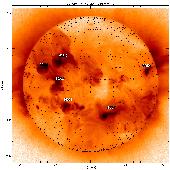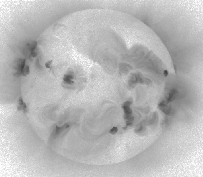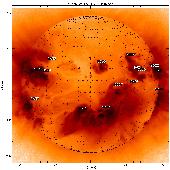
The GOES background flux, which had risen to a C1-2 level a couple of weeks ago, seems now to have settled down to below the C level. This drop is certainly because an active region complex, more specifically, NOAA active regions 9628 and 9632, rotated beyond the limb. These two regions were at around 20 degrees south latitude, separated by less than 20 degrees from each other, and appeared almost like one large region in our soft X-ray images. The first region produced an X2.6 flare on September 24, while the other showed beautiful spiny arcades for a few days after September 28. Both of these circumstances have been the topics of recent science nuggets (see the 28-Sep-01 and 5-Oct-01 editions).
Come to think of it, the last previous X-class flare, August 25, also occurred in a similar location; its region extended 280-300 degrees in Carrington longitude at 20 degrees in the southern hemisphere. Are those exactly the same region, or not? If so, it's interesting to understand how it maintained its vigor for a month. Even if not, it's also interesting to trace the evolution of a whole region.
Trying to trace the birthpoint of this region, one will have to go back to late July, two rotations before the most recent disk passage. Unfortunately, the true date and place of birth were hidden behind the limb. It is only known that the region appeared from behind the east limb as a small, weak sigmoid on 27-July and was given a number, 9557, by NOAA.

Being buried among other bright regions, our future star performer was not distinguished in youth. If you check carefully the movie below, however, it turns out that this young sigmoid repeated small eruptions several times, as if anticipating the future spectacles it was to perform. One notable event is the rapid emergence of magnetic fields occurred on 4-August. It was so remarkable that a flare alert was sent out from Boulder, Colorado, on August 5. In defiance of the alert, just like a child in a rebellious phase, NOAA 9557 then sulkily went behind the limb without producing any distinct eruption.
Here are movies of the July rotation of this region. Click on the movie strip to get a Java movie, if you have a high bandwidth internet connection. If you have only a modem internet connection, click on MPEG instead:
But look at the remarkable jump-up of the proton flux on August 16! This turned out to be associated with a spectacular CME detected by SoHO/LASCO_C2. What was most amazing was the fact that no counterpart was found in the usual places - neither in the GOES X-ray flux nor in coronal images taken at the time.
 Satellite Environment Plot
Satellite Environment Plot
 SXT image (16-aug-01 00:44)
SXT image (16-aug-01 00:44)
Now, NOAA 9557, which must have been near the central meridian on the far side, is suspected as the most probable source of the CME. Of course, no one can be sure about the evolution on the invisible hemisphere (but see the SWAN story ), Without other information, some other origin for this CME might be plausible. Based on the LASCO movie, however, the explosion appears to have come from an area a little to the south and on the central meridian, just expected vicinity of NOAA 9557.
More description, plots and images about this event will be found in a web page at the Solar UK Research Facility (SURF) .
Hiding behind the Sun to leap out and frighten the Earth... no doubt a youthful indiscretion!
When this tempestuous region made its second disk passage in late August, it had grown up to become an active complex. It now consisted of the main sunspot, NOAA 9591, plus a vaguely sigmoidal structure a little east of the spot. Another small sunspot, NOAA 9590, in the southwest, was also effective in making the region complex look larger. The most notable event during this rotation was an X5.3 flare that occurred at 9591 on August 26.

A simple-minded story could simply be that NOAA 9591 could be exactly identified with NOAA 9557 in its previous rotation, and in between numbers it caused the back-side proton event. However, a calculation of the differential rotation rate and speculation of the change of the magnetic field patterns show that NOAA 9557 probably corresponded better to the vague sigmoid rather than to NOAA 9591. This implies that the 9591 must have newly emerged and grown rapidly while it was in the far side of the disk. The younger 9591 could also have been the true source of the backside event on August 16, but who would know?
As already described in the Introduction, the complex region remained active into its third rotation. Seen with SXT, the whole appearance was similar to that during the previous rotation, but the configuration of the sunspots in white-light images showed further evolution. The most noticeable change was the emergence of the large sunspot, NOAA 9532, the source of the X2.6 flare. This region seemed to emerge just at the location where the vague sigmoid had decayed. On the other hand, the western part of the region, NOAA 9628, appeared to be the evolved 9591, according to the similarity of the field pattern in magnetograph images. This region was a typical sunspot in decay phase, showing a complicated mixture of polarities which continue to emerge. It produced several M-class flares, including the one with the gorgeous spiny arcades.

The enhanced flare activity, which (gloomy thought) may be the last splurge of this solar maximum, was observed from mid-August through late-September. It was mainly brought by an active region complex, which appeared at around 20 degrees in the south in this period. Although it is traceable for three rotations as an active complex, it is not the simple growth and decay of a single region. Rather, this is a result of the rapid and significant growth of the magnetic flux over a broader area, which occurred at least three times to form three different regions, NOAA 9557, 9591, and 9532. They all emerged almost on the latitude line of 20 degrees, south, and between 280-300 degrees in Carrington longitude.
October 12, 2001